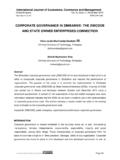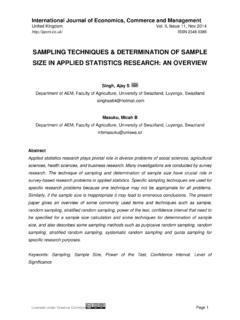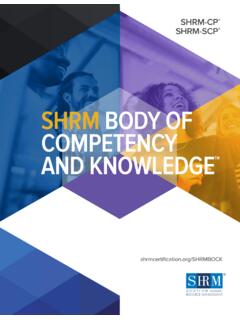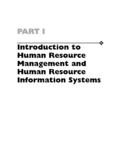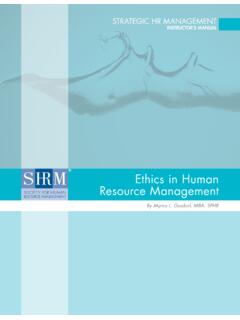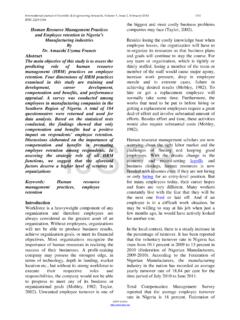Transcription of A CRITICAL ANALYSIS OF HUMAN RESOURCE …
1 International Journal of Economics, Commerce and management United Kingdom Vol. II, Issue 9, Sep 2014 Licensed under Creative Common Page 1 ` ISSN 2348 0386 A CRITICAL ANALYSIS OF HUMAN RESOURCE management PRACTICES INFLUENCING PERFORMANCE IN PUBLIC UNIVERSITIES (CASE STUDY OF UNIVERSITIES IN NAIROBI ) Agusioma, Nickson lumwagi Multimedia University of Kenya, Kenya Gommans, Henry Peter Mount Kenya University, Kenya Kihiko, Moses Kibe Mount Kenya University, Kenya Abstract It is a common phenomenon for all organizations to put more emphasis on good management practices that most impacts on employee s motivation and subsequent performance. This has to be done in cognizance of the prevailing environmental factors such as colleagues, who influences to a great extent their error rate, level of innovation and collaboration with other employees, absenteeism and, ultimately, the labour turnover. The Study was confined within the public universities in Nairobi Central business District, Kenya.
2 Study employed a descriptive research design. The target population for this study was employees of public universities in Nairobi County at top, middle and lower level of management . This is a group that was thought to give the best and most reliable results on the ANALYSIS of HUMAN RESOURCE management practices that influences organization performance. Stratified random sampling was used to select the population from which a sample 160 respondents was drawn. Data was collected mainly by use of questionnaires. SPSS was used to generate the statistical outputs. The study found that recruitment and selection, training and development, reward management and Agusioma, Gommans & Kihiko Licensed under Creative Common Page 2 employee relations affect organization performance. It was concluded that the coefficient of determination showed that of variations in the organization performance is explained by the independent variable stated above.
3 It can also be concluded that HUMAN RESOURCE management Practices are key in determining the organization performance of public universities in Kenya. The study concluded that there is relationship between the independent variables and dependent variables are positive, meaning that they play a major role in organizations performance. Keywords: HUMAN RESOURCE management , employee, organizational performance, public universities, Kenya INTRODUCTION You cannot continuously improve interdependent systems and processes until you progressively perfect interdependent, interpersonal relationships (Stephen, 2003). Thus the quality of both management practices and employees a big influence all the public universities performance. it is this that most impacts on the level of employee s motivation and subsequent performance. The employees interact with the environmental factors including their colleagues who to a big extent influence the error rate, level of innovation and collaboration with other employees, absenteeism and, ultimately the labour turn over in public universities.
4 Public universities being owned by the Government have a lot of job security with regular audits. Harmonious relations between each higher education employer and its employees are necessary to that endeavor (Parisi, 1999). Relations between each higher education employer and its employees may assure that the responsibilities and authorities granted to the separate institutions under the Constitution and by statute are carried out in an atmosphere which permits the fullest participation by employees in the determination of conditions of employment which affect them (Nzuve, 2007). It is only from the management practices and employees attitudes that will determine the performance of public universities in Kenya. It is obvious from the study that, good performance is highly affected by the HUMAN RESOURCE management practices which are adhered to in the public universities. Settled employees at work place, play a major role in determining the rate of performance in all public universities.
5 It is not easy to meet the demands of all employees particularly when the resources are limited, but, however during boom the situation is different because the organization is in position to meet the demands of the employees (Nzuve, 2007). International Journal of Economics, Commerce and management , United Kingdom Licensed under Creative Common Page 3 Statement of the problem Modern organizations are really striving to remain a float in this dynamic world where performance to every management . Line managers should be involved in designing HRM practices and survey should be conducted among employees to know their opinion on these practices (Pakistan business review 2012). The intent of these HUMAN RESOURCE and workplace practices is to increase organizational performance. Nayaab et el (2011) found that effective HUMAN RESOURCE practices contribute a lot to the performance of organizations. Oakland Johns (1989) emphasises that everybody in an organization has a role to play.
6 He suggests that managers must hence plan strategically to maintain hold on market share, let alone increase it and that Total Quality management (TQM ) depends on each individual at each level making proper HUMAN RESOURCE department hence HUMAN RESOURCE practices are indispensable. It is known that HRM practices can positively affect organizational performance. Numerous studies have shown a positive relationship between HRM practices and organizational performance. In order to effectively investigate whether HUMAN RESOURCE practices are capable of contributing to organization performance, it is pragmatic to examine HRM practices in as many settings as possible Abeysekera (2007). Most of the studies in HRM practices and organizational performance have been conducted in the West, on the domestic operations of US firms, with a smaller number of studies carried out in Kenya ( Guest & Hoq).
7 These industry issues and problems demand that firms continually assess its internal processes and capabilities if it is to remain competitive. It is known that HRM can positively affect organizational performance. Numerous studies have shown a positive relationship between HRM practices and organizational performance and its relationship soomro et al. (2011). However, previous studies in Kenya are quite limited in investigating this phenomenon. The general consensus developed among researchers is that HRM practices do not lead directly to business performance. Rather they influence firm s resources, such as the HUMAN capital of the firm (skills, knowledge, & potential), or employee behaviors, and it is these resources that ultimately lead to performance (Wright et al 1994; Delery 1998). This implicit model assumes that there are mediating variables between HRM practices and organizational performance, although, rather few researchers (Paul and Anantharaman 2003) have measured these mediators and addressed their importance.
8 Rizov and Croucher (2008) empirically examined the relationship of HRM practices and organizational performance in European firms. They found that collaborative form of HRM practices (characterized by valuing employees as assets and core partners, creating and communicating a culture of partnership between employer and employees as well as among employees, communicating organization s mission, values, goals and strategy statement through explicit open communication policy and strong Agusioma, Gommans & Kihiko Licensed under Creative Common Page 4 support for employees consultative bodies like unions and committees) reflected positive and statistically significant association with firms performance. Ahmed and Schroeder (2003) investigated effects of selective hiring, employment security, decentralization and use of teams, incentive and compensation, extensive training, status differences, and information sharing on organizational performance (quality, cost, flexibility, delivery and commitment).
9 Owing to the above, vast majority of empirical research on this topic is focused on the performance issue, and most studies show that well directed HUMAN RESOURCE management practices do increase firm s performance (Berg et al. 1996; Huselid 1995). But what are the effects of these practices on workers and hence on the competitiveness or performance of an organization? This question is rarely asked or examined in the HUMAN RESOURCE practices literature. It is against the backdrop of these that the study sought to establish the effects of HUMAN RESOURCE management practices on organizational performance with a specific focus on the public universities in Kenya. LITERATURE REVIEW The main objective was to do a CRITICAL ANALYSIS of HUMAN RESOURCE management practices that influences performance in public universities. It is focused on public universities in the Nairobi County. The specific objectives of the study were to analyze Recruitment and selection, training and development, reward management and employee relation on organization performance.
10 Performance management is a strategic and integrated approach to delivering sustained success to organizations by improving the performance of the people who work in them and developing the capabilities of teams and individual contributors (Armstrong and Baron, 2009). Though various factors do affect this main objective of any organization performance, employee relations is, of late, also emerging to be a major factor influencing organization performance. The chapter was therefore divided into theoretical background and orientation related to the study, empirical and CRITICAL reviews, conceptualization as well as operationalization. This was done with the main aim of enhancing the researcher s understanding of the study area as well as identifying gaps that this study filled. Theoretical Review and Objective Formulation Currently HUMAN Resources have been recognized as an important source of sustained competitive advantage, Barney (1995).




